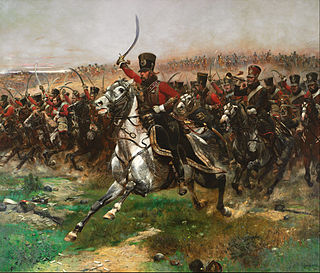
Historically, cavalry are soldiers or warriors who fight mounted on horseback. Cavalry were the most mobile of the combat arms, operating as light cavalry in the roles of reconnaissance, screening, and skirmishing in many armies, or as heavy cavalry for decisive shock attacks in other armies. An individual soldier in the cavalry is known by a number of designations depending on era and tactics, such as cavalryman, horseman, trooper, cataphract, knight, hussar, uhlan, mamluk, cuirassier, lancer, dragoon, or horse archer. The designation of cavalry was not usually given to any military forces that used other animals for mounts, such as camels or elephants. Infantry who moved on horseback, but dismounted to fight on foot, were known in the early 17th to the early 18th century as dragoons, a class of mounted infantry which in most armies later evolved into standard cavalry while retaining their historic designation.

Medieval warfare is the European warfare of the Middle Ages. Technological, cultural, and social developments had forced a severe transformation in the character of warfare from antiquity, changing military tactics and the role of cavalry and artillery. In terms of fortification, the Middle Ages saw the emergence of the castle in Europe, which then spread to the Holy Land.

A cataphract was a form of armored heavy cavalryman that originated in Persia and was fielded in ancient warfare throughout Eurasia and Northern Africa.

A composite bow is a traditional bow made from horn, wood, and sinew laminated together, a form of laminated bow. The horn is on the belly, facing the archer, and sinew on the outer side of a wooden core. When the bow is drawn, the sinew and horn store more energy than wood for the same length of bow. The strength can be made similar to that of all-wood "self" bows, with similar draw-length and therefore a similar amount of energy delivered to the arrow from a much shorter bow. However, making a composite bow requires more varieties of material than a self bow, its construction takes much more time, and the finished bow is more sensitive to moisture.

Light cavalry comprises lightly armed and armored cavalry troops mounted on fast horses, as opposed to heavy cavalry, where the mounted riders were heavily armored. The purpose of light cavalry was primarily raiding, reconnaissance, screening, skirmishing, patrolling and tactical communications. Prior to the early 17th century they were usually armed with swords, spears, javelins, or bows, and later on with sabres, pistols, shotguns, or carbines.
The līmitāneī, meaning respectively "the soldiers in frontier districts" or "the soldiers on the riverbank", were an important part of the late Roman and early Byzantine army after the reorganizations of the late 3rd and early 4th centuries. The limitanei, unlike the comitātēnsēs, palātīnī, and scholæ, garrisoned fortifications along the borders of the Roman Empire and were not normally expected to fight far from their fortifications.

The Byzantine army was the primary military body of the Byzantine armed forces, serving alongside the Byzantine navy. A direct continuation of the Eastern Roman army, shaping and developing itself on the legacy of the late Hellenistic armies, it maintained a similar level of discipline, strategic prowess and organization. It was among the most effective armies of western Eurasia for much of the Middle Ages. Over time the cavalry arm became more prominent in the Byzantine army as the legion system disappeared in the early 7th century. Later reforms reflected some Germanic and Asian influences – rival forces frequently became sources of mercenary units e.g.; Huns, Cumans, Alans and Turks, meeting the Empire's demand for light cavalry mercenaries. Since much of the Byzantine military focused on the strategy and skill of generals utilizing militia troops, heavy infantry were recruited from Frankish and later Varangian mercenaries.

The Byzantine army evolved from that of the late Roman period taking as leading models and shaping itself on the late Hellenistic armies, but it became considerably more sophisticated in strategy, tactics and organization. The language of the army was still Latin, although later Greek dominated, as it became the official language of the entire empire. Unlike the Roman legions, its strength was in its cavalry, especially the armoured cataphracts, which evolved from the clibanarii of the late empire. Infantry were still used but mainly as a base of maneuver for the cavalry, as well as in specialized roles. Most of the foot-soldiers of the empire were the armoured skutatoi and later on, kontarioi, with the remainder being the light infantry and archers of the psiloi. The Byzantines valued intelligence and discipline in their soldiers far more than bravery or brawn. The "Ρωμαίοι στρατιώται" were a loyal force composed of citizens willing to fight to defend their homes and their state to the death, augmented by mercenaries. The training was very much like that of the legionaries, with the soldiers taught close combat techniques with their swords, spears and axes, along with the extensive practice of archery.
The Battle of Strasbourg, also known as the Battle of Argentoratum, was fought in 357 between the Western Roman army under the Caesar Julian and the Alamanni tribal confederation led by the joint paramount King Chnodomar. The battle took place near Strasbourg, called Argentoratum in Ammianus Marcellinus' account, Argentorate in the Tabula Peutingeriana.

Roman military personal equipment was produced in small numbers to established patterns, and used in an established manner. These standard patterns and uses were called the res militaris or disciplina. Its regular practice during the Roman Republic and Roman Empire led to military excellence and victory. The equipment gave the Romans a very distinct advantage over their barbarian enemies, especially so in the case of armour. This does not mean that every Roman soldier had better equipment than the richer men among his opponents. According to Edward Luttwak, Roman equipment was not of a better quality than that used by the majority of Rome's adversaries. Other historians and writers have stated that the Roman army's need for large quantities of "mass produced" equipment after the Marian Reforms and subsequent civil wars led to a decline in the quality of Roman equipment compared to the earlier Republican era:
The production of these kinds of helmets of Italic tradition decreased in quality because of the demands of equipping huge armies, especially during civil wars...The bad quality of these helmets is recorded by the sources describing how sometimes they were covered by wicker protections, like those of Pompeius' soldiers during the siege of Dyrrachium in 48 BC, which were seriously damaged by the missiles of Caesar's slingers and archers.
It would appear that armour quality suffered at times when mass production methods were being used to meet the increased demand ..." and "...the reduced size curiasses would also have been quicker and cheaper to produce, which may have been a deciding factor at times of financial crisis, or where large bodies of men were required to be mobilized at short notice, possibly reflected in the poor-quality, mass produced iron helmets of Imperial Italic type C, as found, for example, in the River Po at Cremona, associated with the Civil Wars of AD 69 AD; Russel-Robinson, 1975, 67
Up until then, the quality of helmets had been fairly consistent and the bowls well decorated and finished. However, after the Marian Reforms, with their resultant influx of the poorest citizens into the army, there must inevitably have been a massive demand for cheaper equipment, a situation which can only have been exacerbated by the Civil Wars...
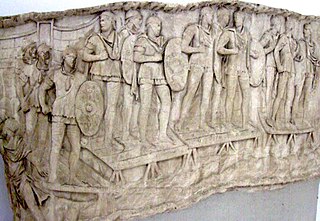
The Auxilia were introduced as non-citizen troops attached to the citizen legions by Augustus after his reorganisation of the Imperial Roman army from 30 BC. By the 2nd century, the Auxilia contained the same number of infantry as the legions and, in addition, provided almost all of the Roman army's cavalry and more specialised troops. The auxilia thus represented three-fifths of Rome's regular land forces at that time. Like their legionary counterparts, auxiliary recruits were mostly volunteers, not conscripts.

For much of history, humans have used some form of cavalry for war and, as a result, cavalry tactics have evolved over time. Tactically, the main advantages of cavalry over infantry troops were greater mobility, a larger impact, and a higher position.
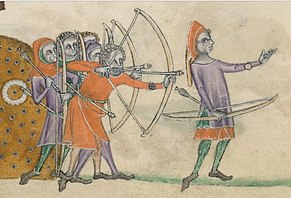
Archery, or the use of bow and arrows, was probably developed in Africa by the later Middle Stone Age. It has been a part of warfare and hunting from the classical period until the late medieval period when it was made obsolete by the increased use of firearms.
The Goths, Gepids, Vandals, and Burgundians were East Germanic groups who appear in Roman records in Late Antiquity. At times these groups warred against or allied with the Roman Empire, the Huns, and various Germanic tribes.
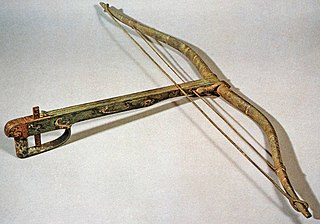
It is not clear where and when the crossbow originated, but it is believed to have appeared in China and Europe around the 7th to 5th centuries BC. In China the crossbow was one of the primary military weapons from the Warring States period until the end of the Han dynasty, when armies composed of up to 30 to 50 percent crossbowmen were not unheard of. The crossbow lost much of its popularity after the fall of the Han dynasty, likely due to the rise of the more resilient heavy cavalry during the Six Dynasties. One Tang dynasty source recommends a bow to crossbow ratio of five to one as well as the utilization of the countermarch to make up for the crossbow's lack of speed. The crossbow countermarch technique was further refined in the Song dynasty, but crossbow usage in the military continued to decline after the Mongol conquest of China. Although the crossbow never regained the prominence it once had under the Han, it was never completely phased out either. Even as late as the 17th century, military theorists were still recommending it for wider military adoption, but production had already shifted in favor of firearms and traditional composite bows.
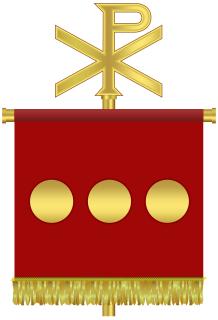
In modern scholarship, the "late" period of the Roman army begins with the accession of the Emperor Diocletian in AD 284, and ends in 476 with the deposition of Romulus Augustulus, being roughly coterminous with the Dominate. During the period 395–476, the army of the Roman Empire's western half progressively disintegrated, while its counterpart in the East, known as the East Roman army remained largely intact in size and structure until the reign of Justinian I.

The Eastern Roman army refers to the army of the eastern section of the Roman Empire, from the empire's definitive split in 395 AD to the army's reorganization by themes after the permanent loss of Syria, Palestine and Egypt to the Arabs in the 7th century during the Byzantine-Arab Wars. The East Roman army is the continuation of the Late Roman army of the 4th century until the Byzantine army of the 7th century onwards.
The palatini were elite units of the Late Roman army mostly attached to the comitatus praesentales, or imperial escort armies. In the elaborate hierarchy of troop-grades, the palatini ranked below the scholares, but above the comitatenses and the limitanei.

A horse archer is a cavalryman armed with a bow and able to shoot while riding from horseback. Archery has occasionally been used from the backs of other riding animals. In large open areas, it was a highly successful technique for hunting, for protecting the herds, and for war. It was a defining characteristic of the Eurasian nomads during antiquity and the medieval period, as well as the Iranian peoples, and Indians in antiquity, and by the Hungarians, Mongols, Chinese, and the Turkic peoples during the Middle Ages. By the expansion of these peoples, the practice also spread to Eastern Europe, Mesopotamia, and East Asia. In East Asia, horse archery came to be particularly honored in the samurai tradition of Japan, where horse archery is called Yabusame.

Equites cataphractarii, or simply cataphractarii, were the most heavily armoured type of Roman cavalry in the Imperial Roman army and Late Roman army. The term derives from a Greek word, κατάφρακτος kataphraktos, meaning "covered over" or "completely covered".















